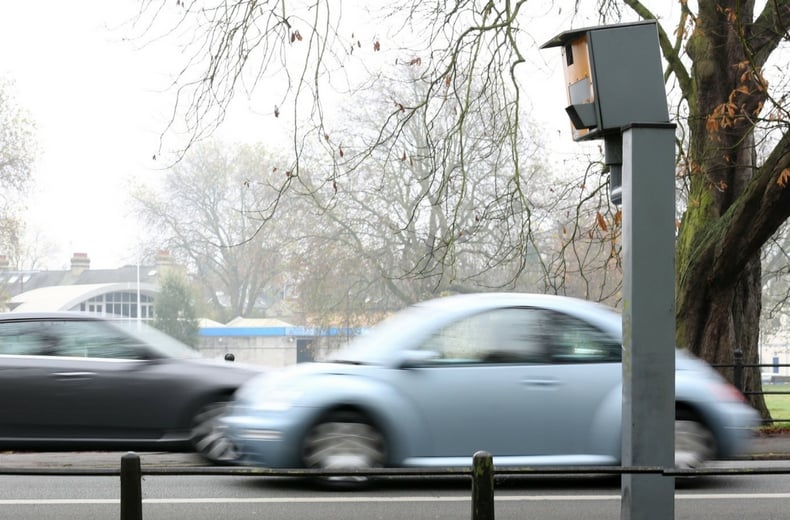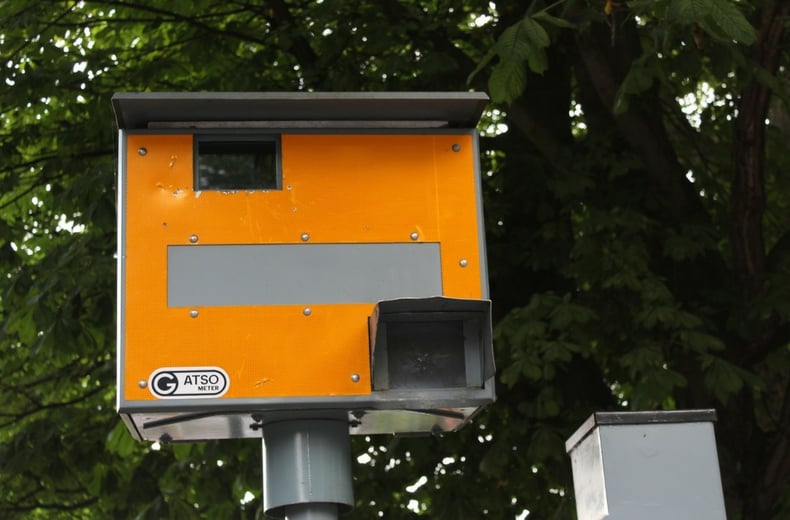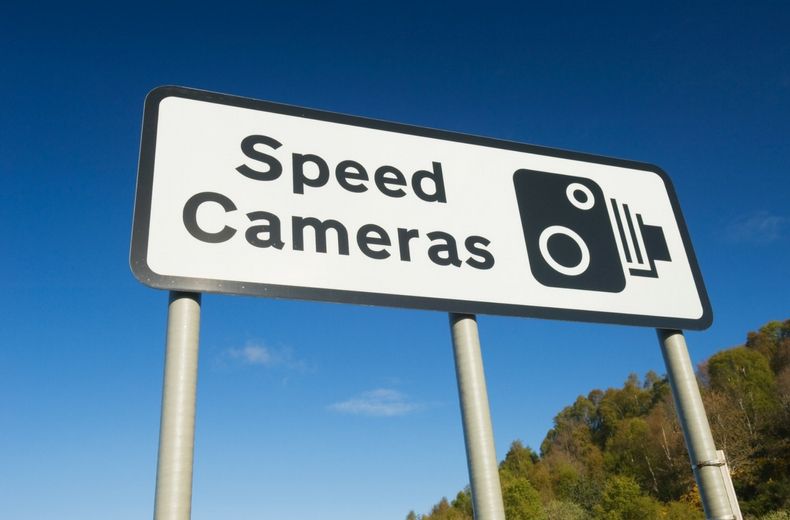Whether you see their benefits or not, you'll have to learn to live with them, so it is advisable to know all you can on the topic to ensure you stay safe and legal.
Speed cameras – the facts

The first speed camera – or safety camera, to use the official terminology – was installed on the A316 over Twickenham Bridge in 1992.
It was a Gatso device, and the trigger speed was set at 60mph: the A316 had a 40mph speed limit.
22 days after being turned on, it caught nearly 23,000 drivers speeding at over 65mph.
How do speed cameras work?
Speed cameras work by recording a vehicle’s speed. It does this by using markings on the road or radar technology to identify the vehicle and record its speed.
Older cameras used film to record speeding offences, but advances in technology has resulted in speed cameras being digitised.
If a vehicle is travelling at excessive speed, two digital images are taken to work out how long it has taken the vehicle to travel between two points on the road. The images also record the vehicle’s registration, time of the offence and speed limit of the road.
In some cases, the image will include the face of the driver and the front passenger.
Not all speed cameras will flash when they take an image of your car and some speed cameras will track your vehicle over many miles to work out its average speed.
Why do we have speed cameras?
Figures from the Royal Society for the Prevention of Accidents (RoSPA)1 reveal that inappropriate speed plays a contributing factor in 11% of all injuries, 15% of serious injuries and 24% of deaths on the road.
Almost 350 people are killed each year on the UK’s roads – with over 2,500 seriously injured – simply because drivers and riders travel too fast.
In 2018, exceeding the speed limit resulted in 12% of all fatal road accidents. 177 people died as a result of speeding according to RoSPA, which argues high speeds make a driver less likely to react to what’s happening around them.
To help combat this, speed cameras are often placed in notoriously accident-prone areas, to have the most significant impact on reducing speed related injuries and deaths.

RAC sale – up to 33% off*
• Roadside cover from £5.49 a month†
• We get to most breakdowns in 60 mins or less
• Our patrols fix 4/5 breakdowns on the spot

Where does the money from speed cameras go?
Since 2000, local authorities have been able to keep a proportion of the money raised by speed cameras, to fund regional schemes.
This led to the establishment of safety camera partnerships between councils and the police, partly funded by the government - although in 2007, funding for these was reduced, and cut further in 2010, leading many regions to turn off speed cameras
Can I drive 10% + 2 above the speed limit and not get caught?
Fixed speed cameras have a set trigger for catching people speeding, however, it is unconfirmed what most are set at so it's not worth gambling and assuming they give you 10% - never exceed the speed limit.
Mobile speeding cameras are operated by individuals, so it is up to their discretion to issue you a speeding fine - or worse - if you are over the legal speed limit.
The law states that you are liable for a speeding fine as soon as you exceed the limit, so if you’re doing 31mph in a 30 limit or 71mph on a motorway, you’re breaking the law and could receive a fine.
The National Police Chiefs’ Council (NPCC) recommends giving drivers a so-called ‘10% plus 2’ leeway, to aid police officers in using 'discretion', however, this is just a recommendation, not the law.
It is well worth remembering this is totally dependent on the officer who catches the speeder, and it is up to that officer whether to fine the offender or not.
The best advice is to not speed full stop.
- Motorway cameras - what you need to know
- Traffic cameras - what you need to know
- Everything you need to know about traffic light cameras
- AI speed cameras - what are they?
How far away can speed cameras catch you from?
Current speed camera technology allows detailed video and images of drivers to be taken from up to one kilometre away.
Most cameras, however, use markings on the road to measure distance over time and determine your speed. SPECS average speed cameras can calculate average speed over distances between 75 metres and 20 kilometres. They appear in sequence on motorways at least 200 metres apart.
Advanced cameras capable of capturing images and videos of drivers up to one kilometre away have been nicknamed ‘Long Rangers’. A successful trial in November 2018 saw 1,293 speeding drivers caught by Gloucester Police and could trigger a national roll-out
- RAC Temporary Car Insurance from 1 hour to 30 days
- RAC Learner Driver Insurance from 1 day to 5 months
- RAC Car Insurance - choose from RAC Comprehensive Car Insurance or RAC Car Insurance Plus
Do speed cameras have to be visible?
All working speed camera on the strategic road network should be painted yellow, although this rule isn’t a legal requirement.
The yellow paint scheme was introduced in 2015 following a review by ministers, with the Government saying it would improve speed camera visibility to ensure motorists were not unfairly penalised.
Some speed cameras can still be difficult to spot, especially mobile units, but the yellow cameras are considered by many to be a significant improvement over the old, grey cameras.
Types of speed cameras
There are many different types of speed camera on the market, but in the UK, a few key types are most common.
Fixed speed cameras

The Gatso was the first speed camera to be installed in the UK and has become the most commonly used camera on UK roads.
Back in 1992 they were painted grey, but a change in the law meant that they have to be painted bright yellow.
The rear-facing Gatso might be the most ‘popular’ camera on the road, but it’s accompanied by the Truvelo, which uses a forward-facing camera to catch speeding motorists.
Unlike the Gatso, it photographs the driver at the wheel, meaning there’s no disputing who was at the wheel at the time of the offence.
Mobile speed cameras

The majority of these are run by local police forces and reside on accident blackspots where there is a history of road traffic incidents over a three year or more period.
There are also mobile speed cameras used as part of safety camera partnership teams and speed safety campaigns.
These cameras can take on a number of forms, working from marked or unmarked cars, as well as being manually operated by police officers using radar guns and laser guns.
.jpg)
There are many FAQs about mobile speed cameras, especially radar guns, so we have answered a few of the most common queries below.
Mobile speed camera FAQs
- How far away does a mobile speed camera work from?
On a straight section of road the typical range for a mobile speed camera is one mile.
- Can you get caught behind another car?
As long as the speed camera operator can see and target your vehicle they will be able to get a reading of your speed.
This is because the laser beam emitted by a mobile speed camera when it hits your vehicle, can be as small as 10cm in diameter.
- How long do I have to bring my speed down?
If the speed limit changes you have to be travelling at that speed the moment you are within the limit boundaries (as soon as you pass the sign).
This means if a speed limit changes from 40 to 30 you will have to bring your speed down to 30 in advance of entering the zone, not begin slowing down as you enter it.
- Can a speed enforcement camera in a van catch people while it's moving?
Mobile speed cameras typically work out of parked vans, however, they can still catch motorists from a moving vehicle.
- Can a mobile camera detect your speed on the opposite side of the road?
Yes, a laser gun is able to take accurate reading of a vehicle’s exact speed as long as it is aimed at the target.
How do average speed cameras work?

Average speed cameras use automatic number plate reading (ANPR) technology to record your speed between two points on a road. The cameras also record the date and time as you pass between each point, enabling the camera to calculate your average speed.
Introduced in 1999, average speed cameras are a common sight on UK roads. You’re also likely to encounter these cameras at roadworks, as well.
Variable speed cameras

Variable speed cameras work in a similar way to average speed cameras, but they’re unlikely to be in operation 24/7.
They tend to be used on smart motorways when the speed limit is lowered to ease congestion or in the event of poor weather or some other hazard.
The speed cameras are situated on the overhead gantries and the limit will be displayed on a series of signs.
Traffic light cameras

Traffic light cameras detect vehicles which pass through lights after they’ve turned red by using sensors or ground loops in the road.
When traffic lights are on red, the system becomes active and the camera is ready to photograph any car that passes over the trigger.
It’s an offence for any part of your vehicle to pass the white stop line if a traffic light has turned red.
The vast majority of red light cameras in the UK are made by Gatsometer.
These Gatso RLC 36 units also have built-in radar technology, with dual speed and red light functions, so for the sake of safety and the law, avoid the temptation to put your foot down when they start to change.
New two-way speed camera
In June 2023, a new type of speed camera was introduced in Devon and Cornwall - with aims of it being introduced more widely across the UK.
New 'bi-directional digital cameras' will replace older speed cameras on roads where there is an increased number of accidents and drivers who are caught speeding.
They are mounted on a tall silver and yellow pole with a camera pointed in opposite directions.
Are speed camera detectors legal?
There are no laws banning speed camera detectors in the UK, although they are illegal (even as a built-in feature of your sat-nav) in many countries in Europe.
Speed camera detectors let users know where speed cameras can be found as they travel. They tend to come in two forms; devices designed to sit on dashboards, or through route planning apps on smartphones.
The detectors use GPS technology to manually update speed camera locations through their own experience, or by downloading online data.
Jammers that ‘block’ the signal from police speed cameras are against the law in the UK and many other countries, and using one could see you slapped with massive fines. Read more about speed camera detector fines in Europe. If you'd like cover for your vehicle if you break down in Europe, check out the RAC's European breakdown cover product now.
Speed cameras FAQs
- How fast do I have to drive to get a speeding ticket?
You can receive a speeding ticket for exceeding the particular speed limit of the road you are driving on.
The law states that you are liable for a speeding fine as soon as you exceed the limit, even by just 1 mph. so if you’re doing 31mph in a 30 limit or 71mph on a motorway, you’re breaking the law and could receive a fine.
- Do speed cameras always flash?
Not all speed cameras give off a visible flash – front-facing Truvelo Combi cameras, for example, use a filter to prevent their flash from dazzling drivers.
Speed guns use radar and laser technology to give an instant speed reading, triggering a police officer to pull over a speeding car, meaning they do not need to flash or capture an image.
If a camera is operating in good light conditions, the flash may not necessarily go off, either.
- Do mobile speed cameras flash?
Handheld speed guns use radar and laser technology to measure your speed, triggering the police to pull over a driver without the need to flash or take a photo.
- Do speed cameras capture your face?
Most speed cameras are rear-facing, but there are exceptions. Truvelo Combi cameras, radar and laser speed guns, and the new ‘Long Ranger’ camera – that can measure speed and check for other driving violations from a kilometre away – all work by facing the front of vehicles.
Speed guns do not capture any images, unlike the Truvelo and ‘Long Ranger’ cameras, that can capture a driver’s face.
- Can speed cameras catch you from the front?
Most speed cameras are rear facing, however there are exceptions. Truvelo Combi cameras, radar and laser speed guns, and the new ‘Long Ranger’ camera – that can measure speed and check for other driving violations from a kilometre away – all work by facing the front of vehicles.
- Can speed camera vans catch you on the opposite side of the road?
Mobile speed cameras use laser technology that can accurately measure your speed as long as the operator can see your vehicle. The lasers have a diameter of 10cm so don’t need to see all of your vehicle from the opposite side of the road to catch you for speeding.
- How do you know if a speed camera is working?
As speed cameras – including speed guns – can measure your speed without the need for a visible flash, there is no way of telling if they are working. The best advice is to not speed full stop.
- Do speed cameras work at night?
In the past, speed cameras have struggled to capture clear images of speeding cars at night, however infra-red technology means that they can now work in low-light night time conditions.
- What colour are speed cameras?
Back in 1992 speed cameras were painted grey, but a change in the law meant that from October 2016, all existing and future cameras have to be painted bright yellow.
- How do mobile speed cameras work?
Mobile speed cameras are usually found in marked vans parked at the side of the road. Those with mini Gatso cameras, use radar technology similar to those on fixed speed cameras.
Mobile units also use radar or laser handheld guns. Laser guns bounce a narrow beam off a moving vehicle to measure its speed in as little as half a second and up to a mile away. Radar guns use a wider beam to take a measurement in around 3 seconds and up to 300 yards away.
- How far away can a speed camera catch you?
The distance that a speed camera can catch you is determined by the type of camera being used. New ‘Long Ranger’ cameras can catch drivers up to a kilometre away, while laser speed guns can measure a vehicle’s speed from up to a mile away.
- Do speed cameras need to be visible?
The government announced plans that all speed cameras must be painted yellow from October 2016. However, there is no law that mobile speed vans and operators have to be visible.
- Do average speed cameras take pictures of the driver?
Average speed cameras use Automatic Number Plate Reading (ANPR) technology, rather than images to measure your speed.
A camera will log a number plate with a time and date stamp and compare the time and date stamp with another camera further along the road. As no images of your vehicle are taken, there’s no need to worry about average speed cameras taking your picture.
- Can you warn drivers of speed traps?
Warning other drivers of speed traps could be treated as the offence: ‘to wilfully obstruct a constable in the execution of his/her duty. Rule 110 of the Highway Code also states that you can’t flash your headlights to convey messages to other motorists
- Do average speed cameras work if you change lanes?
Yes. Average speed cameras take pictures of every lane and can measure your speed regardless of any lane changes.
- Do speed camera vans flash?
Handheld speed guns and mobile speed cameras in vans use radar and laser technology to measure your speed, which operate without the need to flash or take a photo.
Get 30 driving tips that will save you money
Running a car isn’t cheap, but there are some easy things you can do to keep your costs down. Get these tips and more useful driving articles sent straight to your inbox now.


Services we offer
- Breakdown Cover
- European Breakdown Cover
- Motorbike Breakdown Cover
- Electric Car Breakdown Cover
- Caravan, Motorhome and Campervan Breakdown Cover
- Business Breakdown Cover
- Van Breakdown Cover
- RAC Approved Garages
- Vehicle servicing
- Vehicle repair
- MOTs
- Mobile mechanics
- RAC Tyres
- RAC Approved Dealers
- RAC Shop
- myRAC app











